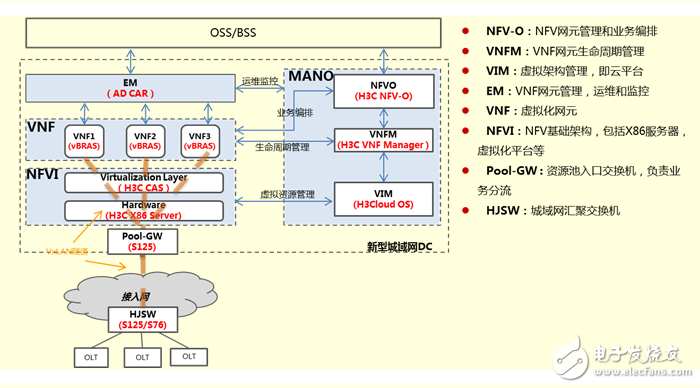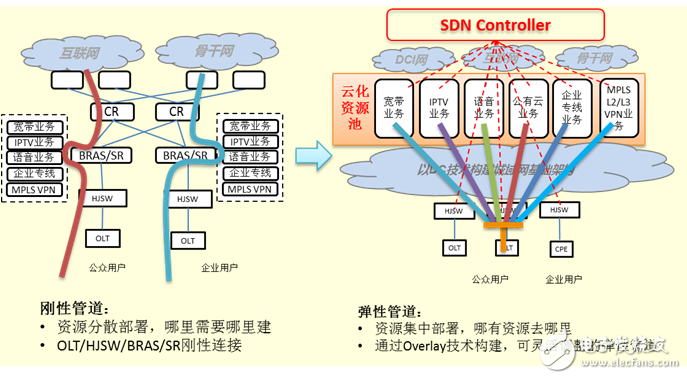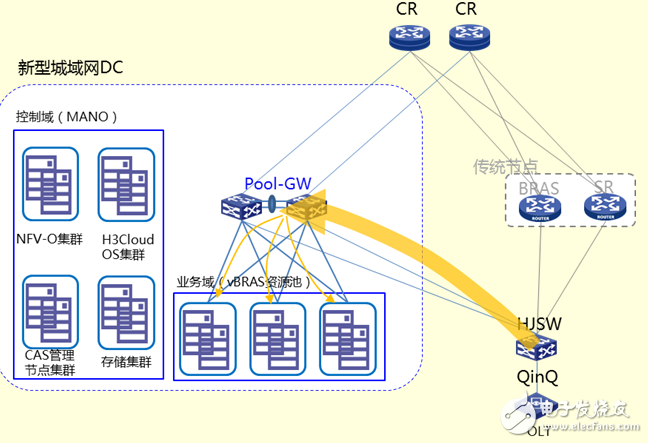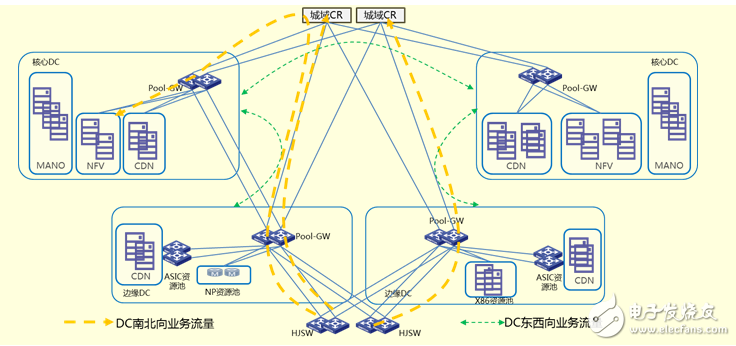The Broadband Remote Access Server (BRAS) is located at the network service provider (POP) of the operating mall's domain network. It is the portal for users to implement various services. As the first hop gateway for users to access the network, the BRAS maintains a large number of user-related services. Attributes, configuration, and status, including: user IP address, PPPoE/IPoE session, QoS, and ACL attributes. These entries and attributes are directly related to the security and quality of service of the user. The key position of the BRAS in the metropolitan area network is not. It goes without saying.
Carrier network reconfiguration is one of the hottest topics in the carrier industry in recent years. CORD is an important part of carrier network reconfiguration. CORD is the abbreviation of Central Office Re-architected as Datacenter. The simple understanding is the DC transformation of the network room. R (ResidenTIal)-CORD, for domestic operators, is the DC transformation of the metropolitan area network.
The metropolitan area network is an important part of the operator network and an important source of revenue for operators. However, with the rapid development of “Internet+†and the challenges of the Internet OTT service, the operator’s metropolitan area network has encountered various Problems and difficulties. Operators are eager to build an open, flexible new metropolitan area network through the reconstruction of the metropolitan area network, namely R-CORD, to reduce costs, increase revenue and enhance competitiveness.
The operating mall domain network includes transmission bearer system, service control system, OSS/BSS system, etc. Each system has a large number of proprietary hardware and private interfaces. The system is closed and the operation is complicated, and the dedicated hardware has poor versatility, high price and easy to be single. Factory lock. The network equipment is dispersed and the load is uneven, resulting in low equipment utilization, which further increases the network construction cost. Operators are eager to solve the above problems through network reconfiguration, R-CORD.
1. Apply SDN, NFV and cloud computing technologies to the metropolitan area networkSDN, NFV, and cloud computing are a common technology that is the most widely used and successful in the Internet industry. The operator's metropolitan area network and the Internet industry's network are very different, so the operation of the mall domain R-CORD has its own characteristics for SDN, NFV and cloud computing applications.
1. DC reconstruction of metropolitan area network
The traditional business systems of the traditional metropolitan area network are independent. The internals of the system are basically dedicated hardware and private interfaces. Resources cannot be shared among the business systems, and the business chimneys are formed one by one. The network construction is basically carried out according to the division of administrative areas. The computer rooms are scattered throughout the country, and the business cannot be dispatched across the computer room, and the intensification of resources and management cannot be achieved. The purpose of DCization is to achieve centralized deployment of resources, build resource pools with cloud computing technology, break business chimneys, achieve resource sharing and unified scheduling, improve resource utilization, and reduce network construction costs.
2.NFV
NFV softens dedicated hardware into virtual network elements and deploys them on a general-purpose X86 server. Operators hope to get rid of the shackles of dedicated hardware through NFV technology, realize the generalization of basic settings and network equipment, and reduce costs. NFV network elements are flexible and can implement functions such as vBRAS, vLNS, vFW, vLB, and vCPE. To start a new service, you only need to upgrade or create a new NFV network element. You do not need to modify the underlying X86 server to implement rapid service deployment. And go online quickly.
3.SDN
SDN technology includes many aspects, one of which is Overlay technology. You can use the VXLAN tunnel of Overlay technology to build a large Layer 2 network, get rid of the physical location restrictions between resource users and resource owners, and do "where to go when there are resources", completely change the original "Where is the need for resources?" The old mode of the implementation of the global scheduling of resources. (As shown in Figure 1)

Figure 1. Transition from traditional rigid pipeline to DC resource pool
Second, the design of the new metropolitan area network vBRAS resource pool solutionThe new metropolitan area network vBRAS resource pool solution is based on SDN, NFV and cloud computing technologies. It follows the standard ETSI NFV architecture and provides standard components such as NFV-O, VNFM, VIM, NFVI, VNF, and EM.

Figure 2. New metropolitan area network vBRAS resource pool solution architecture
The new metropolitan area network vBRAS resource pool solution combines multiple vBRAS network elements into a resource pool, deployed on the NFVI infrastructure, and manages and orchestrate services through MANO. The aggregation switch of the access network diverts the user's service to the front-end switch Pool-GW of the new metropolitan area network (DC) through the VXLAN tunnel, and then the service is offloaded to the specific vBRAS network element in the resource pool. The pool-GW is the ingress switch of the resource pool. It can shield the network element changes in the resource pool. The aggregation switch of the access network only needs to establish a VXLAN tunnel with the pool-GW. The vBRAS NE changes and expansions in the resource pool will not be aggregated. The switch has any impact, which simplifies the management of the access network and enables real resource pooling.
The new metropolitan area network vBRAS resource pool solution is a complete R-CORD solution, and it is also an open solution. Each component can realize the interoperability of different manufacturers, which is the decoupling that operators often say. Decoupling of VIM, decoupling of NFVI, decoupling of virtualization platforms. Xinhua III is also actively participating in the decoupling test of the Carrier Research Institute and the decoupling pilot work of the local market. In 2016, Xinhua San and the China Telecom Beijing Research Institute completed the decoupling test of each component under the ETSI NFV standard architecture. Interoperability between multiple manufacturers.
Third, the practical application of the new metropolitan area network vBRAS resource pool solution in the operation of the mall domain network
Figure 3. Typical networking of the vBRAS resource pool solution
Figure 3 shows a typical networking of the new metropolitan area network (DC), which has been deployed in Jiangsu Telecom, Jiangxi Telecom, and Shandong Unicom. The control domain and the service domain are deployed in the DC. To improve the reliability, the management components of the control domain are deployed in a cluster. The vBRAS resource pool of the service domain is hanged under the Pool-GW. The Pool-GW is used as the entire DC or resource. Uniform entrance and exit of the pool. The remote aggregation switch accesses the Pool-GW through the VXLAN tunnel, and then the Pool-GW branches the VBLAN network to each vBRAS network element for processing. In actual implementation, some local offices still retain the traditional BRAS/SR equipment for carrying traditional broadband services, but only switch the large-session small-traffic services to the vBRAS resource pool bearers. The main purpose is to start with some services. Fully profitable, protect existing investments, and gradually realize the reconstruction of the entire network. Of course, there are also sites that use the vBRAS resource pool to do full-service bearers.
The new metropolitan area network solution is also gradually improved and improved with the reconfiguration of the operator network. Before 2016, it was basically a single vBRAS network element function verification and small-scale pilot. In 2016, the vBRAS resource pool was deployed and the scale users were supported. In 2017, it began to invest in the construction of multi-level DCs to meet the needs of the entire metropolitan area network reconstruction in a single city.

Figure 4. Multi-level DC networking
Figure 4 is a networking diagram of a multi-level DC of a metropolitan area network of a certain city. Based on the H3C new metropolitan area network solution, a two-level DC is constructed, in which two core DCs and multiple edge DCs. The core DC mainly carries services that require centralized control, such as ITMS/RMS, VOIP, and so on. The edge DCs mainly carry services that are sensitive to delay and services such as broadband Internet services and IPTV services. A DC link is established between the DCs. The two core DCs can be backed up to each other. All services can be globally scheduled between the two core DCs. Each aggregation switch doubles up to two edge DCs, a single edge DC failure or a single uplink link failure of the aggregation switch, and the service can quickly switch to another edge DC.
ConclusionR-CORD for carrier network reconfiguration is a long-term and complex task, and it is also an imperative for operators. Through the commercial deployment of multiple cities in multiple operators, the new metropolitan area network solution realizes the scale of service bearer, enabling operators to truly feel the cost advantage and technical advantage. At the same time, the new metropolitan area network solution will be continuously developed and improved according to the requirements of the carrier network and services, so as to better support the operator network reconfiguration work.
Advanced and reasonable system design, stable display effect, easy installation and maintenance, high definition and high resolution. All-day work: vivid colors, high refresh rate, anti-static, dust-proof, good heat dissipation effect, and high cost performance. Display mode: move left and right , moving up and down, pulling the screen left, pulling the screen right, opening and closing in the middle, flickering, display and other methods. Using the program editing and playing software, you can edit, add, delete and modify text, graphics, images and other information through the mouse. The content of the arrangement is stored in the control card, and the information playback is automatically displayed in a loop according to the program table.
Shopping Mall Signs,Shopping Mall Led Sign Board,Shopping Center Led Billboard,Shopping Center Sign
Guangdong Rayee Optoelectronic Technology Co.,Ltd. , https://www.rayeeled.com